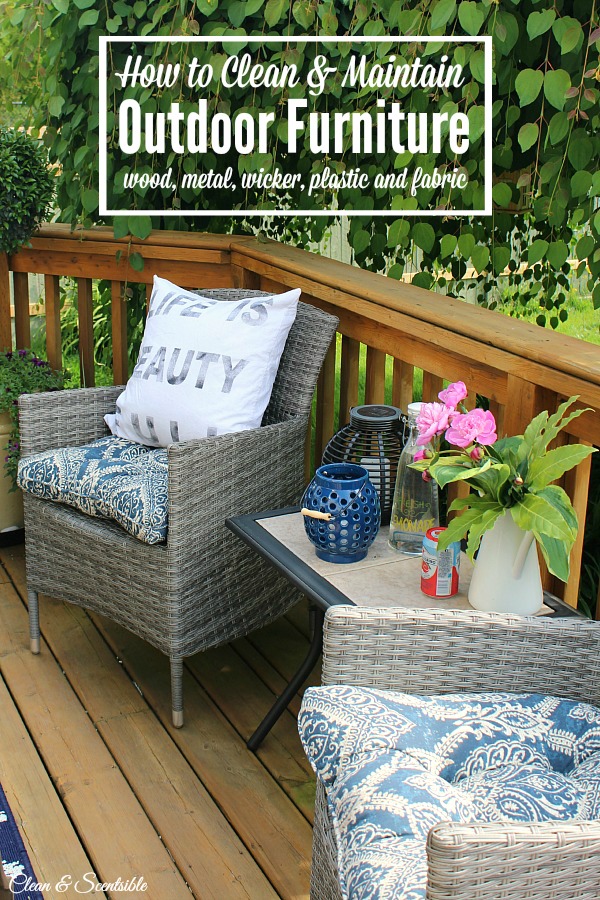Wicker furniture can add a touch of elegance and warmth to any room or outdoor space. Its intricate weaving and natural look make it a favorite among homeowners and decorators alike.
But, as beautiful as wicker is, it requires some attention to keep it looking its best. Have you ever noticed dust and dirt building up in the crevices of your wicker pieces? Or perhaps you’ve seen a bit of fading over time?
If you’re nodding yes, don’t worry—you’re not alone. You value your wicker’s charm and durability, and that’s why maintaining it is essential. With the right care, your wicker furniture can continue to be a stunning centerpiece in your home for years to come. Imagine walking into a room with sparkling clean wicker that looks as good as new, impressing guests and making you proud of your space. Wouldn’t that be wonderful? You’ll discover easy steps to clean and maintain your wicker, ensuring it remains a lovely part of your home decor. You’ll learn how simple actions can prevent damage and extend the life of your furniture. Let’s dive into these valuable tips that will transform your approach to caring for wicker and leave you feeling confident and satisfied with your efforts.
Types Of Wicker Materials
Cleaning and maintaining wicker furniture depends on the material. Natural wicker requires gentle cleaning with a damp cloth. Synthetic wicker is more durable and can be washed with mild soap and water. Regular dusting and covering when not in use helps prolong its life and maintain its appearance.
Wicker furniture adds a touch of elegance and warmth to any space. But did you know that the type of wicker material can affect how you clean and maintain it? Understanding the differences between natural and synthetic wicker can help you keep your pieces looking pristine and ensure they last for years. Let’s dive into the types of wicker materials, focusing on their unique characteristics and common uses.Natural Vs Synthetic
Natural wicker is crafted from plant-based materials like rattan, bamboo, or willow. It’s known for its earthy appearance and flexibility. Have you ever noticed how natural wicker seems to blend seamlessly with outdoor settings? That’s one of its charms. But, it’s also prone to wear when exposed to elements like moisture and sunlight. This means you’ll need to be extra diligent with cleaning and protecting it. Synthetic wicker, on the other hand, is usually made from resin or vinyl. It’s designed to mimic the look of natural wicker but offers greater durability. Imagine having a set of patio furniture that withstands harsh weather without losing its appeal. That’s the advantage of synthetic wicker. You’ll find it’s easier to clean and maintain, making it a favorite for busy households.Common Uses
Natural wicker is often used in indoor furniture, decorative baskets, and light fixtures. Its aesthetic appeal makes it perfect for living rooms or sunrooms. Picture a cozy reading nook with a natural wicker chair; it invites relaxation. Synthetic wicker shines in outdoor settings. It’s commonly found in garden chairs, patio tables, and poolside loungers. If you’re someone who loves hosting backyard barbecues, synthetic wicker furniture might be your best ally. It withstands spills and splashes, making cleanup a breeze. Do you have a favorite wicker piece at home? Whether it’s natural or synthetic, understanding its material can transform your cleaning routine and extend its lifespan. Next time you’re shopping or maintaining your wicker, consider what suits your lifestyle best.Essential Cleaning Tools
Dusting with a soft brush keeps wicker looking fresh. Mild soap and warm water clean spots gently. Dry thoroughly to prevent damage.
Cleaning and maintaining wicker furniture can seem daunting, but with the right tools, it becomes a straightforward task. The key to keeping your wicker looking great is using the appropriate cleaning tools that cater specifically to its unique structure. Let’s delve into the essentials that will help you maintain the beauty and longevity of your wicker furniture.Brushes And Cloths
A variety of brushes and cloths can be your best friends when cleaning wicker. A soft-bristle brush is ideal for dusting off dirt without damaging the fibers. On the other hand, a toothbrush can reach those tricky spots and crevices where dust tends to hide. Microfiber cloths are excellent for wiping surfaces gently. They trap dust effectively and leave the wicker looking fresh. It’s always wise to keep a few different sizes and types of cloths on hand for various cleaning tasks.Cleaning Solutions
The right cleaning solution makes all the difference in maintaining wicker. A mild soap mixed with warm water is often sufficient for routine cleaning. Use a small amount on your cloth or brush to prevent soaking the wicker, which could weaken it over time. For stubborn stains, consider using a solution of vinegar and water. This natural cleaner is effective and safe for the environment. Always test any cleaning solution on a small, inconspicuous area first to ensure it doesn’t discolor your wicker. Have you ever noticed how regular cleaning can transform your furniture? A friend once shared how a simple vinegar and water mix restored her grandmother’s wicker chair to its former glory. It was a testament to how the right tools and solutions can breathe new life into old furniture. What essential tools do you rely on for maintaining your wicker furniture? Whether it’s a trusty brush or a go-to cleaning solution, having the right tools makes all the difference.Routine Cleaning Steps
Gently dust wicker furniture weekly to prevent dirt buildup. Use a soft brush or vacuum with a brush attachment. For deeper cleaning, mix mild soap with water, dampen a cloth, and wipe down the surface. Allow it to dry thoroughly before using again to keep it in good condition.
Keeping your wicker furniture looking fresh and beautiful is easier than you might think. Regular maintenance is key to ensuring its longevity and appearance. You’ll find that a little attention goes a long way in preserving your wicker pieces. Let’s dive into some routine cleaning steps that will help you maintain your wicker furniture in top condition.Dust Removal
Begin by removing dust and loose dirt. Use a soft-bristle brush or a vacuum cleaner with a brush attachment. Gently sweep or vacuum the surface to lift away dust without damaging the wicker fibers. If you have outdoor wicker furniture, you might find more dirt accumulation. In such cases, a little extra care can make a big difference. A microfiber cloth can help you reach into the crevices that a brush might miss. Make dust removal a regular habit to prevent dirt from embedding into the weave. This simple step can keep your wicker looking clean and inviting.Deep Cleaning Techniques
For a more thorough clean, prepare a solution of warm water and mild dish soap. Dip a soft cloth into the soapy water, then wring it out well. You want the cloth damp, not soaking wet, to avoid saturating the wicker. Gently wipe down the furniture, paying attention to any spots with stains or buildup. Use a toothbrush for hard-to-reach areas, such as corners or intricate designs. If your furniture has any stubborn stains, a mixture of white vinegar and water can be an effective spot cleaner. Just be sure to test on a small area first to avoid discoloration. Rinse the wicker with a clean, damp cloth to remove any soap residue. Allow your furniture to air dry completely, ideally in a shaded area to prevent sun damage. Have you ever thought about how the right cleaning routine can extend the life of your furniture? By investing a little time into these routine cleaning steps, you can enjoy your wicker pieces for many years to come.
Credit: www.gainesville.com
Stain Removal Tips
Cleaning wicker requires gentle care to preserve its beauty. Dust regularly with a soft brush or vacuum attachment. For deeper cleaning, use mild soap and water, ensuring thorough drying to prevent damage. Regular maintenance keeps wicker furniture looking fresh and prolongs its lifespan.
Cleaning and maintaining wicker furniture can be a satisfying task that extends its life and keeps it looking fresh. However, stains can sometimes be stubborn and require special attention. Whether it’s an accidental spill or everyday dirt, knowing the right techniques to remove stains can make all the difference.Spot Cleaning Methods
For quick and simple stains, spot cleaning can be incredibly effective. Use a soft cloth dampened with a mild soap and water solution to gently dab the stained area. Avoid rubbing, as this can push the stain further into the wicker fibers. If the stain is still visible, try using a soft-bristled toothbrush. This can help lift the stain without damaging the delicate weave of the wicker. Always remember to dry the area thoroughly, as moisture can lead to mildew.Dealing With Tough Stains
Sometimes, stains are more stubborn and require a stronger approach. For tough stains, a mixture of white vinegar and water can be surprisingly effective. Apply the solution to the stain using a spray bottle, then gently scrub with a toothbrush. If the stain persists, consider using a small amount of baking soda. Sprinkle it on the stain and let it sit for a few minutes before wiping it away with a damp cloth. This can help lift ingrained dirt and odors without harsh chemicals. Have you ever thought about what causes these tough stains in the first place? Identifying the source can help prevent future stains and make maintenance easier. Regularly check your wicker for signs of dirt buildup and address them promptly. If you take a moment to clean spills immediately, you can save yourself a lot of trouble later on. Remember, prompt action is key to keeping your wicker looking pristine. Are there particular stains you’ve struggled with before? Share your experiences and solutions in the comments below. Your input could help someone else tackle their tricky stain situation!Preventive Measures
To keep wicker furniture looking its best, regular cleaning is essential. Dust with a soft brush or vacuum to remove dirt. Occasionally, wipe with a damp cloth and mild soap to prevent grime buildup.
Cleaning and maintaining wicker furniture can be a rewarding task that extends its lifespan and keeps it looking fresh. The best way to ensure your wicker remains in top condition is by implementing preventive measures. These actions safeguard your wicker against damage and reduce the need for frequent repairs or replacements. Let’s dive into some practical ways you can protect your wicker furniture.Protective Coatings
Applying a protective coating is a simple yet effective way to shield your wicker. Consider using a clear varnish or a water-based sealant. These coatings act as a barrier against moisture, dust, and dirt. Imagine your wicker furniture as a well-loved book. You wouldn’t leave it exposed to the elements without a cover, right? A coating provides that protective layer, keeping your furniture safe from wear and tear. Don’t forget to reapply the coating regularly, especially if your wicker is kept outdoors. This ensures continued protection and helps maintain its natural sheen.Avoiding Damage
Preventing damage is crucial in maintaining wicker’s elegance. Always lift wicker furniture when moving it instead of dragging it across the floor. Dragging can cause splits and scratches, damaging the intricate weave. Think about how you handle delicate items in your home. You wouldn’t toss a fragile vase around carelessly. Treat your wicker with the same care, and it will reward you with longevity. Consider the placement of your wicker pieces. Avoid areas with direct sunlight or excessive humidity, as these can weaken the fibers over time. Isn’t it interesting how small adjustments can have a big impact on preserving your furniture’s beauty? By taking these preventive measures, you’re investing in the durability of your wicker—ensuring it remains a cherished part of your space for years to come. What steps will you take to protect your wicker furniture today?
Credit: ganapaticrafts.com
Storage And Care
Wicker furniture adds charm to any space. Proper storage and care extend its lifespan. Knowing how to store wicker prevents damage and wear.
Indoor Vs Outdoor Storage
Indoor storage keeps wicker safe from weather. Temperature and humidity control are key indoors. Sunlight can fade wicker’s color over time.
Outdoor storage requires more attention. Protect wicker from rain and sun. Use covers or move it inside during bad weather.
Seasonal Care Tips
Winter months need extra care. Move wicker inside to avoid cold damage. Clean wicker before storing it for winter.
Spring is perfect for refreshing wicker. Dust and wash wicker surfaces. Inspect for any signs of wear or damage.
Summer heat can affect wicker. Keep it shaded to prevent drying. Moisture can cause mold, so monitor humidity levels.
Autumn brings cooler temperatures. Wicker stays sturdy but still needs care. Clean and repair any damages before winter arrives.
Repair And Restoration
Wicker furniture offers natural beauty and charm. Yet, it can wear over time. Proper care ensures its longevity and appeal. Repairing and restoring wicker becomes essential when it shows signs of damage. Addressing these issues promptly prevents further deterioration. This section guides you on fixing broken strands and exploring professional restoration options.
Fixing Broken Strands
Identify the broken strands first. Use a magnifying glass for a closer look. Gather necessary tools like scissors and glue. Cut a new strand slightly longer than needed. Weave it in where the old one broke. Apply glue for extra hold. Let it dry completely. Check the repair for stability. Repeat if needed.
Professional Restoration Options
Sometimes, DIY repairs aren’t enough. Professional restoration offers a thorough solution. Experts have the right tools and materials. They assess the damage accurately. They weave new strands seamlessly. This service ensures a perfect match in color and texture. It may cost more. Yet, it extends the life of your wicker.
Enhancing Durability
Wicker furniture lasts longer with gentle cleaning and regular maintenance. Dust with a soft brush weekly to prevent dirt build-up. For deeper cleaning, use a mild soap solution and a damp cloth.
Enhancing the durability of your wicker furniture is essential if you want it to last for years. Wicker, with its natural charm, can be sensitive to wear and tear if not properly cared for. A little effort in its maintenance can go a long way. Imagine relaxing on your wicker chair knowing it will stay beautiful and sturdy for years. Let’s dive into how you can achieve this.Regular Maintenance Schedule
Create a cleaning routine to keep your wicker looking fresh. Dust accumulates quickly, especially in intricate patterns. Consider a weekly dusting session using a soft brush or cloth. Every few months, give it a deeper clean with soapy water. Gently scrub the surface and rinse thoroughly. Ensure it dries completely to prevent mold and mildew. Think of it like scheduling a check-up for your wicker. Consistency in cleaning prevents damage and maintains its appeal.Choosing Quality Products
The products you choose for cleaning can make a difference. Opt for mild detergents that protect the wicker’s natural fibers. Harsh chemicals can lead to fading and brittleness. Look for specialized wicker care products that offer protection against UV rays. These products not only cleanse but also shield the material from sun damage. You might wonder: does this really matter? It does. Using quality products ensures longevity and preserves the wicker’s elegance. Enhancing the durability of your wicker furniture isn’t just about maintenance. It’s about enjoying its charm without worrying about its fragility. Are you ready to see your wicker furniture withstand the test of time?
Credit: draperandkramer.com
Frequently Asked Questions
How Do You Clean And Preserve Wicker?
Clean wicker with a soft brush and mild soap. Dry completely to prevent mold. Apply lemon oil for preservation. Store wicker indoors during extreme weather. Regular maintenance extends the lifespan of wicker furniture.
How Do You Make Wicker Look New Again?
Clean wicker gently using a soft brush and mild soap solution. Rinse thoroughly and let it dry. Apply a fresh coat of paint or varnish for added shine. Regular maintenance keeps wicker looking new. Avoid direct sunlight to prevent fading and brittleness.
Does Wicker Need To Be Oiled?
Wicker benefits from being oiled, preventing it from drying and cracking. Use linseed oil or tung oil for best results. Regular oiling enhances durability and appearance, keeping wicker furniture in good condition. Oiling also helps maintain the natural shine and flexibility of the wicker fibers.
Is It Okay To Hose Down Wicker Furniture?
Hosing down wicker furniture is generally safe. Use a gentle spray to avoid damaging the weave. Dry it thoroughly to prevent mold. Regular cleaning helps maintain its appearance and longevity. Always check manufacturer guidelines for specific care instructions.
Conclusion
Wicker furniture adds charm to any space. Proper cleaning keeps it fresh. Dust regularly and wipe with a damp cloth. Avoid harsh chemicals that damage fibers. Sun exposure can fade colors, so keep it shaded. Repair breaks promptly to maintain integrity.
A little care goes a long way. Your wicker will stay beautiful with routine attention. Enjoy its timeless appeal and comfort. These simple steps ensure your wicker stays in great condition. Keep your space inviting and stylish with well-maintained wicker.
The beauty of wicker awaits you!


